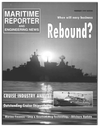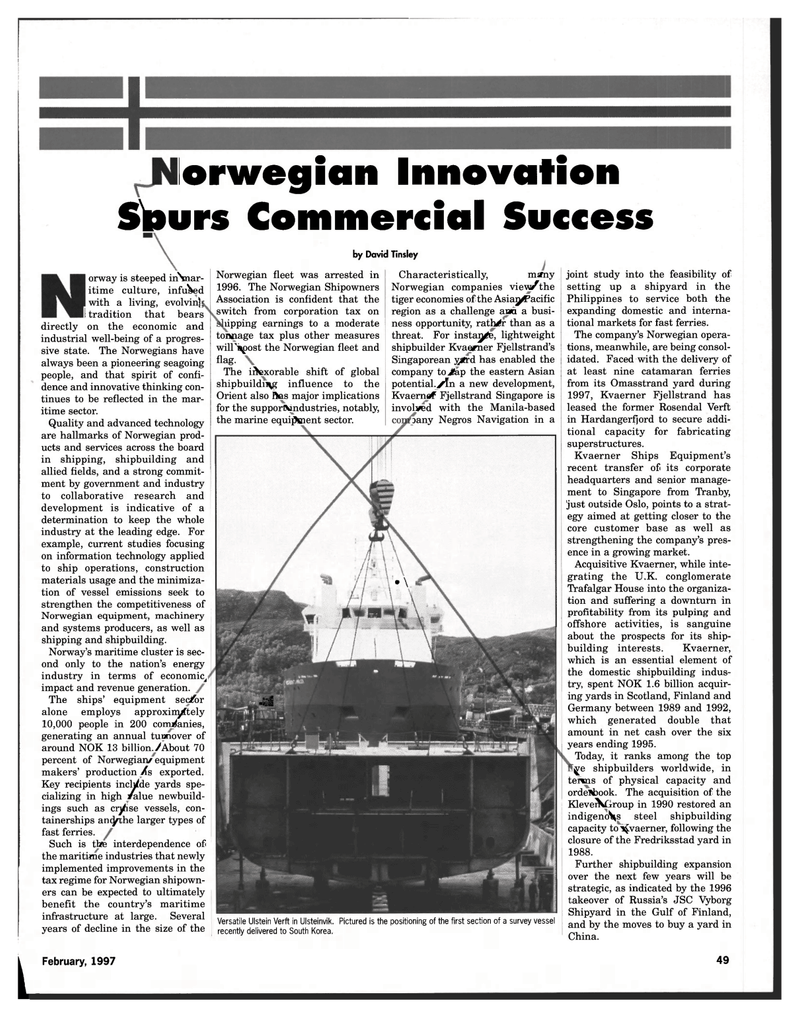
Page 49: of Maritime Reporter Magazine (February 1997)
Read this page in Pdf, Flash or Html5 edition of February 1997 Maritime Reporter Magazine
lorwegicm Innovation
Sburs Commercial Success
L orway is steeped inNmar- itime culture, infused with a living, evolvin)
I tradition that bears directly on the economic and industrial well-being of a progres- sive state. The Norwegians have always been a pioneering seagoing people, and that spirit of confi- dence and innovative thinking con- tinues to be reflected in the mar- itime sector.
Quality and advanced technology are hallmarks of Norwegian prod- ucts and services across the board in shipping, shipbuilding and allied fields, and a strong commit- ment by government and industry to collaborative research and development is indicative of a determination to keep the whole industry at the leading edge. For example, current studies focusing on information technology applied to ship operations, construction materials usage and the minimiza- tion of vessel emissions seek to strengthen the competitiveness of
Norwegian equipment, machinery and systems producers, as well as shipping and shipbuilding.
Norway's maritime cluster is sec- ond only to the nation's energy industry in terms of economic^ impact and revenue generation.
The ships' equipment sedfor alone employs approxinyftely 10,000 people in 200 companies, generating an annual turnover of around NOK 13 bill ion VAbout 70 percent of Norwegiansequipment makers' production As exported.
Key recipients include yards spe- cializing in high /alue newbuild- ings such as cr-yise vessels, con- tainerships anc^nihe larger types of fast ferries.
Such is thfe interdependence of the maritime industries that newly implemented improvements in the tax regime for Norwegian shipown- ers can be expected to ultimately benefit the country's maritime infrastructure at large. Several years of decline in the size of the
February, 1997 by David Tinsley
Norwegian fleet was arrested in 1996. The Norwegian Shipowners
Association is confident that the switch from corporation tax on lipping earnings to a moderate tonnage tax plus other measures will spost the Norwegian fleet and flag.
The inexorable shift of global shipbuilding influence to the
Orient also ftas major implications for the supportondustries, notably, the marine equipment sector.
Characteristically, many
Norwegian companies view^the tiger economies of the Asia^Pacific region as a challenge aaa a busi- ness opportunity, rather than as a threat. For instate, lightweight shipbuilder Kvaenier Fjellstrand's
Singaporean yard has enabled the company to Jfap the eastern Asian potential.ytn a new development,
KvaerMf Fjellstrand Singapore is invoh^d with the Manila-based jany Negros Navigation in a » \ „ |
Versatile Ulstein Verft in Ulsteinvik. Pictured is the positioning of the first section of a survey vessel recently delivered to South Korea. joint study into the feasibility of setting up a shipyard in the
Philippines to service both the expanding domestic and interna- tional markets for fast ferries.
The company's Norwegian opera- tions, meanwhile, are being consol- idated. Faced with the delivery of at least nine catamaran ferries from its Omasstrand yard during 1997, Kvaerner Fjellstrand has leased the former Rosendal Verft in Hardangerfjord to secure addi- tional capacity for fabricating superstructures.
Kvaerner Ships Equipment's recent transfer of its corporate headquarters and senior manage- ment to Singapore from Tranby, just outside Oslo, points to a strat- egy aimed at getting closer to the core customer base as well as strengthening the company's pres- ence in a growing market.
Acquisitive Kvaerner, while inte- grating the U.K. conglomerate
Trafalgar House into the organiza- tion and suffering a downturn in profitability from its pulping and offshore activities, is sanguine about the prospects for its ship- building interests. Kvaerner, which is an essential element of the domestic shipbuilding indus- try, spent NOK 1.6 billion acquir- ing yards in Scotland, Finland and
Germany between 1989 and 1992, which generated double that amount in net cash over the six years ending 1995.
Today, it ranks among the top ^e shipbuilders worldwide, in terois of physical capacity and ordelbook. The acquisition of the
KleveiWxroup in 1990 restored an indigenoS^s steel shipbuilding capacity to \£vaerner, following the closure of the Fredriksstad yard in 1988.
Further shipbuilding expansion over the next few years will be strategic, as indicated by the 1996 takeover of Russia's JSC Vyborg
Shipyard in the Gulf of Finland, and by the moves to buy a yard in
China. 49

 48
48

 50
50
